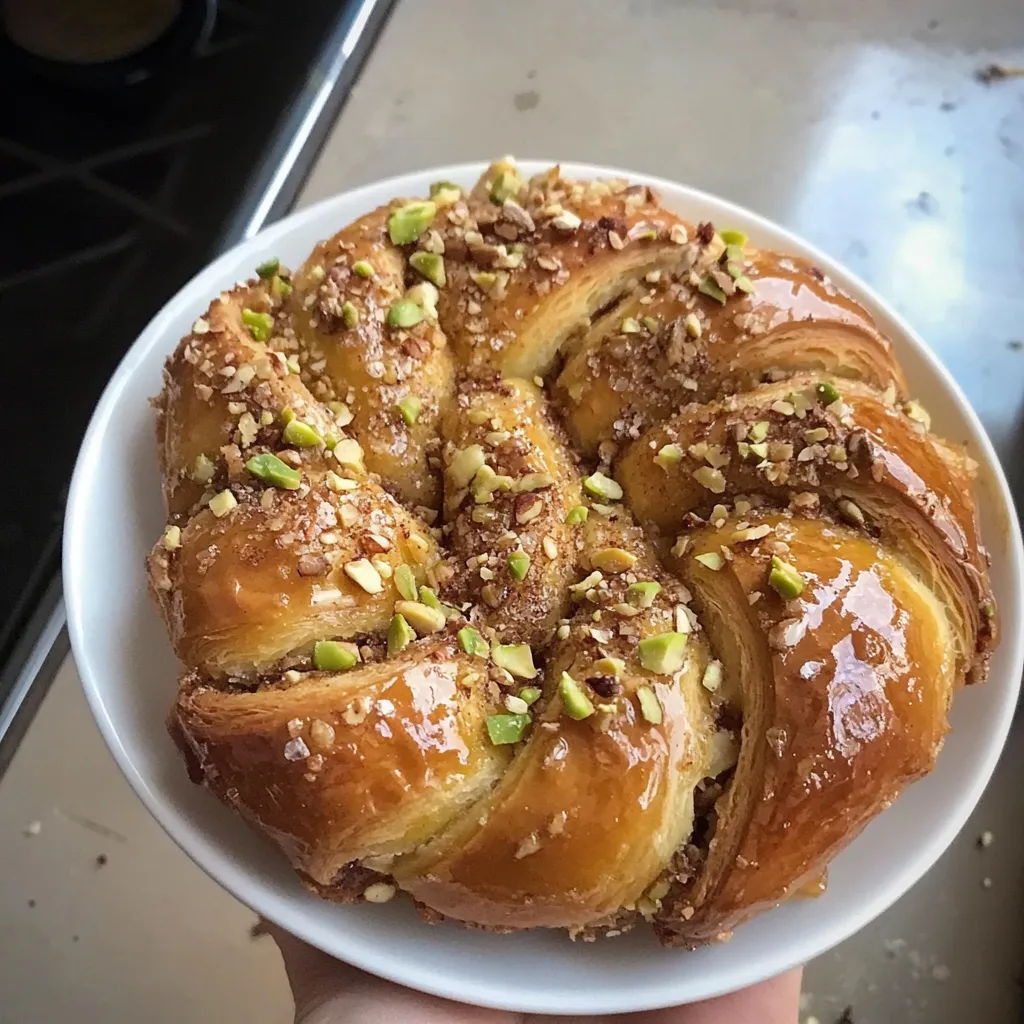 Pin it
Pin it
These baklava babka buns came to life during a Sunday baking experiment when I couldn't decide between making babka or baklava for a family gathering. My grandmother is Jewish and my grandfather is Greek, so I grew up loving both treats! I thought, "Why not combine them?" The result was these incredible swirled buns with the buttery, yeasty goodness of babka filled with the nutty, honey-soaked magic of baklava. They've become our special occasion breakfast tradition - nothing says "I love you" like a sticky, sweet, cinnamon-scented bun!
My aunt, who's an incredible baker herself, actually asked for my recipe after trying these at our last holiday brunch! My teenage son, who typically races through breakfast, was spotted savoring each bite and licking his fingers afterward. There's something about that combination of buttery dough, warm spices, and honey-soaked nuts that makes everyone slow down and truly enjoy the eating experience.
Ingredients
- Active dry yeast: Creates that perfectly soft, pillowy dough that's the foundation of these buns. I've tried using instant yeast when that's all I had on hand, and while it works, I prefer the flavor development from active dry.
- Warm milk: Adds richness to the dough that water simply can't match. I've tried making these with non-dairy milk for my lactose-intolerant niece, and almond milk works surprisingly well!
- Mixed nuts: The combination of walnuts and pistachios creates the perfect balance of earthy and sweet flavors, plus that gorgeous color contrast. I sometimes throw in a handful of almonds too when I have them.
- Cinnamon: This warm spice ties everything together. I've experimented with adding a pinch of cardamom or cloves for complexity, but always come back to the simple perfection of just cinnamon.
- Honey: The heart and soul of the syrup that transforms these from regular buns to something extraordinary. I use whatever honey I have on hand, but orange blossom honey adds a lovely floral note if you can find it.
 Pin it
Pin it
Step-by-Step Instructions
- Perfect dough consistency
- Creating that ideal babka dough starts with proper mixing. I combine the dry ingredients first, then add the wet ingredients gradually. The dough should be soft and slightly sticky but still pull away from the sides of the bowl. The first time I made these, my dough was too dry and the buns turned out dense. Now I know to trust the process - it will become less sticky after kneading and rising.
- Filling texture
- Achieving that perfect nut filling takes attention to detail. I chop the nuts finely but not to dust - you want some texture! A food processor works great, but pulse carefully to avoid turning them into nut butter. My first attempt had nuts that were too coarsely chopped, creating gaps in the filling. Now I aim for pieces about the size of small peas for the perfect bite.
- Rolling technique
- Creating those beautiful swirls requires a gentle touch. Roll the dough into a large, thin rectangle - the thinner you can go without tearing, the more swirls you'll get. Spread the filling evenly, leaving a small border around the edges. When rolling it up, keep it tight but don't pull or stretch the dough, which can tear it. I roll from the long side for more swirls, though rolling from the short side gives you fewer, larger swirls.
- Twisting method
- Making those gorgeous twisted buns is actually simpler than it looks! After rolling the dough into a log, I chill it for about 15 minutes if it's gotten too soft. Then I cut it lengthwise down the middle, creating two long strips with exposed layers. Twist these strips around each other, then coil into a bun shape. Don't worry about perfection - the more rustic they look, the better they turn out, somehow!
- Baking wisdom
- Achieving that perfect golden color without overbaking takes attention. I check them about 5 minutes before the recipe time - oven temperatures vary so much! You want them deeply golden on top but still soft in the center. If they're browning too quickly, I tent them with foil for the remaining bake time.
- Syrup soaking
- Creating that signature sticky baklava finish requires proper timing. I make the syrup while the buns are baking so it's ready to go. Pour it over the buns while they're still warm (but not piping hot) from the oven - this helps them absorb the maximum amount of syrupy goodness. I poke a few small holes in the tops with a toothpick to help the syrup penetrate deeper.
I've been tweaking this recipe for about three years now, gradually perfecting the ratio of nuts to cinnamon and the amount of syrup. My original version used a lot more honey, which made them too sweet and soggy. I've also played with different nuts - hazelnuts make a delicious variation, and pecans give a Southern twist to this Mediterranean-inspired treat. My daughter prefers when I add a little orange zest to the dough, which does brighten the flavor beautifully.
Morning Magic
These spectacular buns deserve special treatment when serving! For holiday breakfasts, I arrange them on my grandmother's vintage cake stand and surround them with fresh berries for color. They pair beautifully with strong coffee or tea to balance the sweetness. For brunch gatherings, I sometimes make a double batch and create a beautiful spiral pattern on a large serving platter. They're substantial enough that one bun is quite filling, though I've never seen anyone stop at just one!
Creative Twists
These versatile buns welcome creative adaptations while maintaining that magical baklava-babka fusion. For a chocolate lover's version, add mini chocolate chips to the filling (dark chocolate pairs wonderfully with the nuts). During fall, try adding diced apples to the filling and a touch of apple pie spice. My husband loves when I spread a thin layer of tahini under the nut filling for a more traditional Middle Eastern flavor. And for a simpler weekday version, you can shape this into one large babka loaf instead of individual buns.
Fresh Keeping
These buns are definitely best enjoyed the day they're made, when the dough is at its softest and the contrast between the syrupy exterior and tender interior is at its peak. If you do have leftovers, store them in an airtight container at room temperature for up to 2 days. To refresh them, warm them gently in a 300°F oven for about 5 minutes, or give them 10-15 seconds in the microwave. The texture won't be quite the same as fresh, but they'll still be delicious!
 Pin it
Pin it
I created these baklava babka buns as a way to honor both sides of my family heritage, but they've become so much more than that. There's something about the process of making them - the kneading, the rolling, the twisting, the wonderful aromas filling the kitchen - that feels almost therapeutic. While they do take some time and attention, most of that is hands-off rising time, and the results are absolutely worth it. The way people's faces light up when they first see (and then taste) them makes all the effort worthwhile!
Frequently Asked Questions
- → Can I make these buns ahead of time?
- Yes! You can prepare the dough and let it rise in the refrigerator overnight. Let it come to room temperature before rolling and filling. You can also freeze the baked buns (before adding syrup) for up to 1 month.
- → Can I use different nuts in the filling?
- Absolutely! Traditional baklava often uses a mixture of walnuts, pistachios, and sometimes almonds or hazelnuts. Feel free to customize with your favorite nuts.
- → How do I store these buns?
- Store in an airtight container at room temperature for up to 3 days. The syrup helps keep them moist. Warm slightly before serving for the best texture and flavor.
- → Why are my buns dry even with the syrup?
- Make sure to pour the syrup over the buns while they're still warm from the oven. This allows the buns to absorb the syrup properly. Also, don't overbake them as this can lead to dryness.
- → What's the best way to twist the dough?
- After rolling the dough into a log, cut it in half lengthwise to expose the layers. Twist the two pieces around each other with the cut sides facing up, then coil into a bun shape. This creates the beautiful swirled effect.
